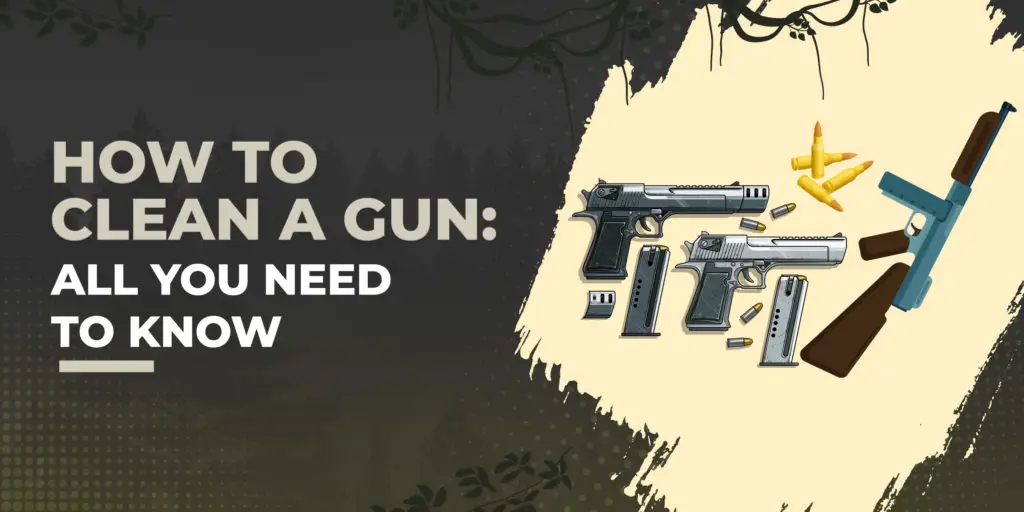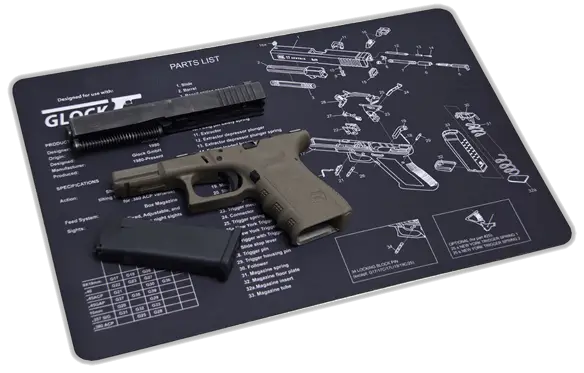
Mechanical devices demand regular and proper maintenance. This certainly includes all firearms which do require a good cleaning and lubrication after use to keep their operational performance at a peak for a survival scenario.
Generally, though, regular maintenance does not imply that a firearm needs to be disassembled to the last screw and spring in order to clean it. Any firearm can get a basic fundamental cleaning in five quick steps.
SKIP AHEAD
How To Clean a Gun: All You Need to Know
1. Unload and Remove Bolt
Before cleaning any gun, open the action to make sure it is unloaded, and then read the owner’s manual for specific gun model instructions. Remove clips or magazines. Take out the bolt in a rifle, or lock open the action of a semi-auto rifle, shotgun, or pistol. Brush with solvent, clean, dry off, and lightly lube the bolt. Make sure you brush the extractor and/or ejector as well.
2. Swab Bore
Set the cleaned bolt aside and working from the breech or chamber end only run a cleaning rod with attached bronze brush soaked in gun solvent down the barrel and out the muzzle. Repeat this same action if the barrel is particularly dirty. Let it sit for 10-15 minutes. This allows the solvent to dissolve and soften bullet jacket material, lead, and powder fowling.
- Removes fouling and carbon
- Prevents carbon fouling
Last update on 2024-04-23 at 14:02 / Affiliate links / Images from Amazon Product Advertising API
3. Scrub Bore
After the solvent soak, run the solvent soaked bronze brush down the barrel again several times to loosen the gunk in the barrel. Purists would say to unscrew the brush at the muzzle at each stroke of the cleaning rod rather than pulling it back up and out the chamber. If you are a professional target shooter, this extra effort might make a difference, however for the average everyday deer rifle or .22 LR, this is not necessary. You make that judgment for your gun especially if the application is law enforcement or security or the like.
After ten or so runs of the brush, I do recommend next running a cloth patch down the bore to push any excess carbon out the muzzle. In this case do not pull the patch back out. Take it off the rod, put on a clean one, and then pull the rod back out the chamber end. Repeat again with the brush scrubbing. As a rule of thumb on most hunting guns running the brush 25 times should do the job.
4. Run Bore with Patches
Next run several solvent soaked patches down the barrel and out the muzzle end. Replace each time with a clean patch, pull back up, and replace patch again. Do this until you are satisfied with the relative cleanliness of the patch. They may never come out completely white, but if they come out black, with shades of blue and green, then keep cleaning. Solvent can turn a lot of barrel fowling bluish or green.
If this continues, you may need to soak the barrel again, rest it, and then brush again. It all depends on how many rounds were shot since the last cleaning. If you deer hunted and shot the gun a half dozen times in a season that is of course much different than running 500 rounds through a .22 rimfire rifle, or a .223 AR rifle on the shooting range or a 9mm handgun doing police qualification shooting.
Another great tool for cleaning the bore of your rifle or pistol is Hoppe's Bore Snake. Here is a quick video product review of the Bore Snake. I own a few of these (Joel) and had success using them.
5. Apply Light Lubrication
Contrary to popular belief guns do not perform well swimming in oil. After all the swabbing and scrubbing, the barrel just needs a light coat of rust prevention oil as does the bolt. Use a clean soft cotton cloth with oil to wipe down all the metal surfaces of the gun. A very little on the wood stock does not hurt it. Don’t overdo oil.
I do this final step wearing those $1 brown cotton gloves to keep fingerprints from ending up on the metal before storage. As to storage, do not put any firearm in any kind of a sealed case, either fabric or plastic for long term. If you do, add a packet of moisture desiccant in the case, otherwise, just prop the gun up safely locked in a closet or secure area. Ammo should be kept in a place separate from guns.
Are there other steps that could be added? Sure. Use a clean toothbrush to dust in the juncture of the barrel were fitted to the stock. Brush off sights, mounts, scope metal, too. Clean optical lenses like any high-quality glass. Brush around the trigger area. Clean the clip or magazine and oil lightly. Brush up into the magazine insert cavity below the action. Brush off the butt plate that usually ends up in the dirt.
There you have completed a basic gun cleaning to prepare for a survival situation. Be sure to check the gun ever so often to make sure no rusting has slipped up on the metal surfaces. It is also a good idea before shooting your gun again to run a dry patch down the barrel to clean out any leftover oil or dust. If you continue to maintain your guns after each use, they will be ready when you need them.
Use a Gun Cleaning Mat
A gun cleaning mat can keep you organized and provide a soft surface. Check out our favorite pick below:
 |
|
View Latest Price |
Best Gun Cleaning Kits
You also buy ready-to-go cleaning kits to make this process easier. Here are our most recommended kits:
| Preview | Product | Rating | |
|---|---|---|---|

|
GLORYFIRE Universal Gun Cleaning Kit Hunting Handgun Shot Gun Cleaning Kit... | See Price on Amazon | |

|
Otis Tactical Universal Gun Cleaning Kit | See Price on Amazon |
Last update on 2024-04-23 at 14:02 / Affiliate links / Images from Amazon Product Advertising API


